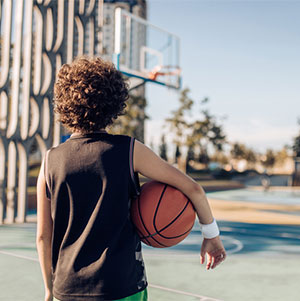Scoliosis and Pediatric Spine Deformity Program
The Bristol-Myers Squibb Children’s Hospital is home to New Jersey’s only comprehensive program for the treatment of scoliosis and other pediatric spinal deformities from birth to young adulthood.
We have a dedicated team of surgeons, anesthesiologists, nurses, neurophysiologists, and brace orthotists who can offer state-of-the-art, evidence-based treatment for your child’s spinal deformity.
Our surgeons have been top providers of scoliosis treatment in New Jersey for more than 40 years. We have the expertise to treat the most challenging early-onset and infantile scoliosis and the ultra-specialized experience and medical support to care for the complex child with neuromuscular scoliosis.
Our pediatric spine surgeons are highly experienced in the surgical and nonsurgical treatment of pediatric spinal disorders.
State-of-the-Art Technology and Multidisciplinary Care

Our team employs state-of-the art technology including 3D navigation, neurophysiologic monitoring, and bloodless surgery innovations to deliver the best results.
We have a talented, multidisciplinary team of surgeons, pediatric intensivists, anesthesiologists, neurophysiologists, pharmacists, and wonderful, dedicated nurses who collaborate through our Spine Quality Improvement Program to deliver an outstanding, safe patient experience.
Specialized Treatment Close to Home
There is no need to travel out of state for your child’s scoliosis care. Highly specialized experts are right here in New Jersey.
Conditions We Treat
Scoliosis
- Early-onset scoliosis (infantile, juvenile, congenital). Some patients present with scoliosis upon birth from a congenital defect or early on as an infant with growth-related scoliosis.
- Adolescent idiopathic (typical) scoliosis. When the spine develops a side-to-side curvature appearing in late childhood or adolescence secondary to asymmetric growth during a growth spurt and without any other known cause.
- Neuromuscular scoliosis. This is one of the three main types of scoliosis causing an irregular spine curvature and it is typically associated with cerebral palsy, spina bifida, many syndromes, and spinal trauma.
Other Spine Deformities
- Cerebral palsy. This disorder affects movement, muscle tone, and/or posture, and it is the most common disability in childhood.
- Cervical instability. Hypermobility of the cervical vertebrae (bones of the neck) move beyond a normal range of motion from loosened ligaments.
- Duchenne’s muscular dystrophy. Primarily affecting boys, this genetic disorder causes frequent falls, difficulty getting up, a waddling gait, large calves, and learning disabilities.
- Klippel Feil syndrome. A condition that affects how the bones in the spine develop in the neck, causing a short neck and low hairline with restricted movement of the upper spine.
- Kyphosis. Kyphosis causes pronounced curvature of the spine and an abnormal upper-back rounding (a “hunchback” or “round back”). Kyphosis can occur at any age. It is also common during adolescence due to bodily changes during puberty, including rapid bone growth.
- Prader-Willie syndrome. This genetic disorder causes weak muscles, poor feeding, and slow development in children who may become obese due to constant feelings of hunger.
- Rett’s syndrome. Primarily affecting girls, this rare genetic condition affects how the brain develops, causing a gradual loss of motor skills and the ability to speak.
- Spina bifida. This congenital abnormality occurs when the spinal cord doesn’t form properly in the womb.
- Spinal muscular atrophy. A genetic disease affecting the central and peripheral nervous systems that progressively destroys motor neurons.
- Spondylolisthesis/spondylolysis. A crack or stress fracture in one of the vertebrae, sometimes causing forward slippage of the spine on itself.
- Spine trauma. Spinal cord injuries can cause substantial long-term effects, including partial or complete paralysis.
- Thoracic insufficiency syndrome. When spinal deformities such as scoliosis, missing or fused ribs, or other severe problems make the chest walls unable to properly support lung development and normal respiration.
Treatments for Scoliosis and Spinal
- State-of-the-art bracing. Scoliosis braces are designed to slow or halt the progression of the sideways curvature of the spine caused by the condition. These are custom made to you and your curvature.
- Schroth physical therapy. A rehabilitation expert uses this physical therapy technique based on the patient’s unique spinal curvature.
- Spinal fusion (posterior, anterior, combined anterior/posterior). This is a method of surgical intervention to partially correct and balance your spine while joining together (fusing) two or more vertebrae to eliminate movement between them.
- Halo-gravity traction. This specialized technique gently stretches and straightens severely compressed or curved spines in children.
- MAGEC rod and other growing rods. These rods are implants into a child’s back during surgery to lengthen the spine with a remote control and powerful magnets. The procedure allows children to grow without the need for repeat surgeries.
- Vertical expandable prosthetic titanium rib (VEPTR). A curved metal rod is surgically attached to a child’s ribs, spine or pelvis used to straighten the spine so the lungs can grow and expand during the child’s development.
Advanced Technology Used in the Diagnosis and Treatment of Scoliosis
- EOS imaging. An ultra low-dose, three-dimensional imaging system to scan the child while standing up to assess the interaction between joints and the spine, hips and legs.
- Neurophysiologic intraoperative monitoring. Continuous monitoring of the central nervous system for all scoliosis patients during spine surgery.
- Bloodless surgery program. Medical care that does not involve blood transfusions for patients who refuse them for religious, medical, or other personal reasons is called bloodless medicine. We utilize several techniques to minimize blood loss during surgery including collecting, filtering, and giving your own blood back to you.
- Spinal navigation - 3D printing and O-arm. Real-time imaging of a patient’s anatomy shown in two- and three-dimensional imagery during surgery to minimize surgical time and increase safety, especially in complex cases.



